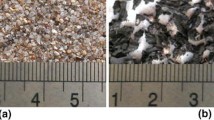Abstract
In this study the stress–strain characteristics of sand-ground rubber mixtures are investigated in the sandlike zone, at different confining pressures, using hollow cylinder specimens subjected to torsional monotonic and cyclic loading. Under monotonic loading a mixture of sand-ground rubber with 10% and 25% rubber content show more contraction behaviour than that observed in a pure sand specimen. Phase transformation point in these mixtures are located on a larger shear strain. As expected, the shear strength of specimens decreases with increase of ground rubber content. However, with increasing of effective confining pressure, the loss in shear strength of the mixture is decreased. In addition, a mixture with 25% ground rubber shows a smaller loss in shear strength compared to a mixture with 10% ground rubber mixture. Under cyclic loading mixtures with 10% and 25% ground rubber have similar liquefaction resistance, especially at confining pressures of 110 kPa and 260 kPa. Therefore, by using of the mixture with 25% ground rubber, a larger volume of scrap tires could be recycled. The addition of ground rubber to sand would affect the shear strain variation and excess pore water pressure trends, and this effect was further intensified with increasing ground rubber percentage.
Similar content being viewed by others
References
Ahmed I and Lovell C (1993), “Rubber Soils as Lightweight Geomaterials,” Transportation Research Record No. 1422. National Academy Press, Washington, DC, 61–70.
Bosscher PJ, Edil TB and Eldin NN (1992), “Construction and Performance of a Shredded Waste Tire Test Embankment,” Transportation Research Record No. 1345. Washington, DC, 44–52.
Eldin NN and Senouci AB (1993), “Rubber-Tire Particles as Concrete Aggregate,” Journal of Materials in Civil Engineering, 5(4): 478–496.
Feng ZY and Sutter KG (2000), “Dynamic Properties of Granulated Rubber/Sand Mixtures,” ASTM geotechnical testing journal, 23(3): 338–344.
Foose GJ, Benson CH and Bosscher PJ (1996), “Sand Reinforced with Shredded Waste Tires,” Journal of Geotechnical Engineering, 122(9): 760–767.
Georgiannou V, Tsomokos A and Stavrou K (2008), “Monotonic and Cyclic Behaviour of Sand under Torsional Loading,” Géotechnique, 58(2): 113–124.
Hazarika H, Yasuhara K, Karmokar A and Mitarai Y (2007), “Shaking Table Test on Liquefaction Prevention using Tire Chips and Sand Mixture,” Paper Presented at the Proceedings of the International Workshop on Scrap Tire Derived Geomaterials—Opportunities and Challenges, Yokosuka, Japan.
Hershey RL, Waugh MD and Hanny EJ (1987), “Waste Tire Utilization,” United States Department of Energy, Office of Industrial Programs.
Humphrey D and Nickels W (1994), “Tire Chips as Subgrade Insulation and Lightweight Fill,” Paper Presented at the Proceedings of the 18th Annual Meeting of the Asphalt Recycling and Reclaiming Association.
Humphrey DN, Sandford TC, Cribbs, MM and Manion WP (1993), “Shear Strength and Compressibility of Tire Chips for Use as Retaining Wall Backfill,” Transportation Research Record No. 1422 National Academy Press, Washington, DC, 29–35.
Ishiraha K, Tatsuoka F and Yasuda S (1975), “Undrained Deformation and Liquefaction of Sand under Cyclic Stress,” J. Soils and Foundations, 15(1): 29–44.
Kawata S, Hyodo M, Orense P, Yamada S and Hazarika H (2007), “Undrained and Drained Shear Behavior of Sand and Tire Chips Composite Material,” Paper Presented at the Proceedings of the International Workshop on Scrap Tire Derived Geomaterials—Opportunities and Challenges, Yokosuka, Japan.
Kim HK and Santamarina J (2008), “Sand-Rubber Mixtures (Large Rubber Chips),” Canadian Geotechnical Journal, 45(10): 1457–1466.
Lee, HJ and Roh HS (2007), “The Use of Recycled Tire Chips to Minimize Dynamic Earth Pressure during Compaction of Backfill,” Construction and Building Materials, 21(5): 1016–1026.
Masad E, Taha R, Ho C and Papagiannakis T (1996), “Engineering Properties of Tire/Soil Mixtures as a Lightweight Fill Material,” Geotechnical Testing Journal, 19(3): 297–304.
Mashiri M, Vinod J and Sheikh MN, (2016), “Liquefaction Potential and Dynamic Properties of Sand Tyre Chip Mixtures,” Geotechnical Testing Journal, 39(1): 69–79.
Mashiri M, Vinod J, Sheikh MN and Tsang HH (2015), “Shear Strength and Dilatancy Behaviour of Sand–Tyre Chip Mixtures,” Soils and Foundations, 55(3): 517–528.
O’Shaughnessy V and Garga VK (2000), “Tire-Reinforced Earthfill. Part 2 Pull-Out Behaviour and Reinforced Slope design,” Canadian Geotechnical Journal, 37(1): 97–116.
Parker Jr R, Stone R, Buchanan C and Steimle Jr F (1974), “How to Build Marine Artificial Reefs,” U. S. National Marine Fisheries Service, Fishery Facts No. 10. 47pp.
Pincus H, Edil T and Bosscher P (1994), “Engineering Properties of Tire Chips and Soil Mixtures,” ASTM Geotechnical Testing Journal, 17(4): 453–464.
Promputthangkoon P and Hyde A (2007), “Compressibility and Liquefaction Potential of Rubber Composite Soils,” Paper Presented at the Scrap Tire Derived Geomaterials-Opportunities and Challenges: Proceedings of the International Workshop IW-TDGM 2007 (Yokosuka, Japan, 23–24. March 2007).
Roberts FL, Kandhal PS, Brown ER and Dunning RL (1989), “Investigation and Evaluation of Ground Tire Rubber in Hot Mix Asphalt,” National Center for Asphalt Technology.
Shahnazari H, Tutunchian MA, Rezvani R and Valizadeh F (2013), “Evolutionary-Based Approaches for Determining the Deviatoric Stress of Calcareous Sands,” Computers & Geosciences, 50: 84–94.
Sze H and Yang J (2014), “Failure Modes of Sand in Undrained Cyclic Loading: Impact of Sample Preparation,” Journal of Geotechnical and Geoenvironmental Engineering, 140(1): 152–169.
Tanaka Y, Sugimoto SA and ADACHI N (2004), “Liquefaction Strength of Coarse-Grained Soils as Determined by Large Torsional Test and the Membrane Penetration Effect on the Strength,” Paper Presented at the 13th World Conference on Earthquake Engineering.
Wu WY, Benda CC and Cauley RF (1997), “Triaxial Determination of Shear Strength of Tire Chips,” Journal of Geotechnical and Geoenvironmental Engineering, 123(5): 479–482.
Author information
Authors and Affiliations
Corresponding author
Rights and permissions
About this article
Cite this article
Shariatmadari, N., Karimpour-Fard, M. & Shargh, A. Undrained monotonic and cyclic behavior of sand-ground rubber mixtures. Earthq. Eng. Eng. Vib. 17, 541–553 (2018). https://doi.org/10.1007/s11803-018-0461-x
Received:
Accepted:
Published:
Issue Date:
DOI: https://doi.org/10.1007/s11803-018-0461-x




